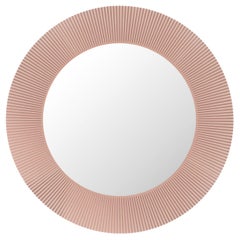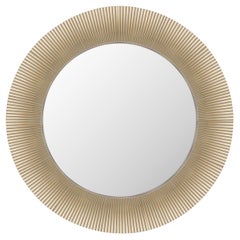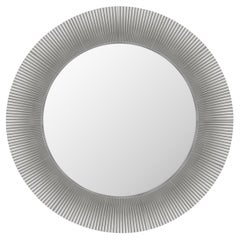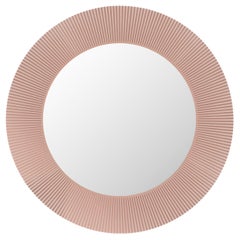Kartell All Saints Mirror
Kartell All Saints Mirror in Copper by Ludovica and Roberto Palomba
By Ludovica + Roberto Palomba 1, Kartell
Located in Brooklyn, NY
Round mirror with a transparent or colored PMMA frame, with a unique pleated effect. The
Category
21st Century and Contemporary Italian Modern Wall Mirrors
Materials
Resin
$1,245 Sale Price / item
20% Off
H 30.71 in W 1.88 in D 30.71 in
Kartell All Saints Mirror in Gold by Ludovica and Roberto Palomba
By Ludovica + Roberto Palomba 1, Kartell
Located in Brooklyn, NY
Round mirror with a transparent or colored PMMA frame, with a unique pleated effect. The
Category
21st Century and Contemporary Italian Modern Wall Mirrors
Materials
Resin
$1,245 Sale Price / item
20% Off
H 30.71 in W 1.88 in D 30.71 in
Kartell All Saints Mirror in Chrome by Ludovica and Roberto Palomba
By Ludovica + Roberto Palomba 1, Kartell
Located in Brooklyn, NY
Round mirror with a transparent or colored PMMA frame, with a unique pleated effect. The
Category
21st Century and Contemporary Italian Modern Wall Mirrors
Materials
Resin
$1,245 Sale Price / item
20% Off
H 30.71 in W 1.88 in D 30.71 in
Kartell All Saints Mirror in Nude by Ludovica and Roberto Palomba
By Ludovica + Roberto Palomba 1, Kartell
Located in Brooklyn, NY
Round mirror with a transparent or colored PMMA frame, with a unique pleated effect. The
Category
21st Century and Contemporary Italian Modern Wall Mirrors
Materials
Resin
$412 Sale Price / item
20% Off
H 30.71 in W 1.88 in D 30.71 in
People Also Browsed
White Alabaster Peono Table Lamp by Simone & Marcel
Located in Geneve, CH
White Alabaster Peono Table Lamp by Simone & Marcel
Dimensions: Ø 40.6 x H 56 cm.
Materials: Brass, acrylic and white alabaster.
Also available in different marble, wood and alabast...
Category
2010s Spanish Post-Modern Table Lamps
Materials
Alabaster, Brass
LU Swing Sconce
By Lumfardo Luminaires
Located in Los Angeles, CA
Beautiful brass LU swing sconce made by Lumfardo Luminaires in patinated brass. Wired with an E26 medium based socket. Light bulb provided as well as all mounting hardware. Priced in...
Category
21st Century and Contemporary American Mid-Century Modern Wall Lights an...
Materials
Brass
Giraffe dining Chair in Solid Brazilian Wood by Juliana Vasconcellos
By Juliana Lima Vasconcellos
Located in Belo Horizonte, Minas Gerais
The Giraffe dining chair was designed with soft curves and slender, but with volume, bringing comfort and elegance. The base structure was thought with three feet. The upholstered se...
Category
21st Century and Contemporary Brazilian Modern Dining Room Chairs
Materials
Wood
$2,360 / item
H 33.47 in W 17.72 in D 20.08 in
Mid-Century Modern Dining Chairs Set of 8
Located in NEW YORK, NY
Mid-Century Modern curved back dining chairs upholstered in black faux leather.
Crafted of solid heavy full grain hardwood with walnut finish.
Perfect for either casual or formal di...
Category
2010s Portuguese Modern Dining Room Chairs
Materials
Faux Leather, Wood
Solid Oak Cabinet, France, 1940s
Located in Kaštel Sućurac, Splitsko-dalmatinska županija
Discover the allure of French craftsmanship with this charming and compact oak buffet from the 1940s. Despite its smaller size, this piece exudes timeless elegance and showcases the ...
Category
Vintage 1940s French French Provincial Buffets
Materials
Oak
Charming Amethyst Pink Disc Murano Chandelier, 1970s
By Vistosi
Located in Rome, IT
The 24 Amethyst discs of precious Murano glass are arranged on three levels.
Available also a chain and canopy and a pair of sconces .
Wired for US standards. Eight E 14 light bu...
Category
Vintage 1970s Italian Mid-Century Modern Chandeliers and Pendants
Materials
Blown Glass
Brutalist Solid Oak Sideboard, France, 1940s
By Charles Dudouyt
Located in Kaštel Sućurac, Splitsko-dalmatinska županija
Large Art Deco Brutalist sideboard, France, 1940.
The credenza consists of three storage facilities with a handcarved foliage on the doors.
The refined wooden structures on the doo...
Category
Vintage 1940s French Mid-Century Modern Buffets
Materials
Oak
$4,043 Sale Price
40% Off
H 40.95 in W 79.14 in D 20.87 in
Hans Agne Jakobsson Pine suspension Sweden 1950's Big model
By Hans-Agne Jakobsson
Located in Forest, BE
Big model pine suspension from the 1950's by Swedish master of lighting Hans Agne Jakobsson. The lamp provide a warm atmosphere and even better when lighted. Made of thin stripes of ...
Category
Vintage 1950s Swedish Scandinavian Modern Chandeliers and Pendants
Materials
Pine
$3,369 Sale Price
20% Off
H 19.69 in Dm 11.82 in
Corbu Cabinet by DeMuro Das in Charcoal Carta & Solid Walnut
By DeMuro Das
Located in New York, NY
Inspired by the graphic motifs of Le Corbusier's mural paintings, the solid form of the Corbu cabinet is defined by rhythmically placed handles. Architectural legs lend support and a...
Category
21st Century and Contemporary Indian Mid-Century Modern Cabinets
Materials
Walnut
Artisan Murano Glass Oval Mirror
By Venfield
Located in New York, NY
Murano art glass framed mirror with brass accents on top, bottom and sides. Italy.
This mirror is currently available in our NYC showroom.
Custom dimensions and colors are availab...
Category
2010s Italian Modern Wall Mirrors
Materials
Brass
'Floatation' Japanese Paper Suspension Lamp for Ingo Maurer
By Ingo Maurer
Located in Glendale, CA
'Floatation' Japanese paper suspension lamp for Ingo Maurer.
Designed and produced by Ingo Maurer, one of the most celebrated German lighting icons since 1966. With imagination, cre...
Category
21st Century and Contemporary German Mid-Century Modern Chandeliers and ...
Materials
Metal, Iron
Giancarlo Mattioli 'Nessino' Table Lamp in White for Artemide
By Giancarlo Mattioli, Artemide
Located in Glendale, CA
Giancarlo Mattioli 'Nessino' table lamp in white for Artemide.
With its mushroom shape and bright hues, the Nessino lamp has become a design icon. Introduced in 1967, the Nessino wa...
Category
21st Century and Contemporary Italian Mid-Century Modern Table Lamps
Materials
Plastic
Solid Natural Oak Credenza, France, 1940s
By Charles Dudouyt, Gaston Poisson
Located in Kaštel Sućurac, Splitsko-dalmatinska županija
Description:
This stunning bleached French buffet, carefully selected by our curator, is a masterpiece of craftsmanship and design from the 1940s. Featuring intricate carvings on it...
Category
Vintage 1940s French Art Deco Buffets
Materials
Oak
20th Century Luigi Massoni for Poltrona Frau Dilly Dally Vanitiy Dressing Table
By Poltrona Frau, Luigi Massoni
Located in Turin, Turin
Dressing table model Dilly Dally designed by Luigi Massoni for Poltrona Frau in 1960s. The dressing table is composed of two pieces, one round armchair (which alone measures 74 x 66 ...
Category
Vintage 1960s Italian Mid-Century Modern Vanities
Materials
Metal
$21,660
H 29.14 in Dm 25.99 in
Pair of Bauhaus Modernist StyleTubular Chairs
Located in New York, NY
Great pair of Bauhaus tubular sling chairs in cowhide and matte steel. The arm covers are black leather that lace up underneath while the seat and back are lace-up cowhide.
Similar ...
Category
Mid-20th Century German Armchairs
Materials
Steel
Brutalist Solid Oak Sideboard, France, 1940s
By Charles Dudouyt, Gaston Poisson, De Coene Frères
Located in Kaštel Sućurac, Splitsko-dalmatinska županija
Credenza, solid oak, France, 1940s.
Large Art Deco Brutalist sideboard. This heavy Brutalist credenza seems to float on its elegant base. The credenza consists of two large storage ...
Category
Vintage 1940s French Brutalist Buffets
Materials
Oak
Get Updated with New Arrivals
Save "Kartell All Saints Mirror", and we’ll notify you when there are new listings in this category.
More Ways To Browse
Japanese Bronze Fisherman
Japanese Fire Screen
Japanese Geisha Dolls
Japanese Iron Tea Pot
Japanese Kanon
Japanese Koi Vase
Japanese Kotatsu
Japanese Moon Flask
Japanese Music Box
Japanese Porcelain Sleeping Cat
Japanese Screen Irises
Japanese Scroll Calligraphy
Japanese Sewing Box
Japanese Sleeping Cat
Japanese Soup Bowl
Japanese Tea Cabinet
Japanese Totai Shippo
Japanese Wood Bucket



